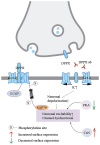Case Report: Treatment of delayed tremor episodes in a patient with DPPX antibody encephalitis
- PMID: 40808961
- PMCID: PMC12343675
- DOI: 10.3389/fimmu.2025.1594823
Case Report: Treatment of delayed tremor episodes in a patient with DPPX antibody encephalitis
Abstract
Introduction: Autoimmune encephalitis is a neurological disease caused by abnormal autoimmune mechanisms, characterized by a range of symptoms such as psychiatric and behavioral abnormalities, cognitive impairment, memory decline, and seizures. It is primarily identified by the presence of autoantibodies against neuronal surface antigens in the cerebrospinal fluid. This disease is relatively rare in clinical settings, and its diagnosis remains challenging, with fewer than a hundred cases reported to date. Particularly, cases of Anti-DPPX encephalitis presenting with delayed myoclonus and blurred vision are extremely rare. This case report emphasizes the complexity of the diagnosis and the effective treatment of Anti-DPPX encephalitis with delayed myoclonus.
Case description: The patient experienced intermittent fever accompanied by severe headaches for one month, with headaches worsening in an upright position, followed by two hours of vomiting, with stomach contents being expelled. Upon admission, the preliminary diagnosis included suspected central nervous system infection and suspected autoimmune encephalitis. Despite receiving anti-infective and antiviral treatments, as well as acid suppressant and gastric protection therapies, the patient's condition continued to deteriorate. Both computed tomography (CT) and magnetic resonance imaging (MRI) showed no apparent abnormalities. Further cerebrospinal fluid and serum tests revealed the presence of anti-DPPX antibodies, confirming the diagnosis of Anti-DPPX encephalitis. The patient underwent a comprehensive treatment regimen, including high-dose steroid pulse therapy, intravenous immunoglobulin, antiviral and anti-infective therapy, as well as acid suppressant and gastric protection treatments. Significant symptom improvement was observed, and by the 8th day of hospitalization, the condition had stabilized. In the 8th month of follow-up, the patient suddenly developed persistent tremor in both hands, without obvious cause. without a recurrence of fever or consciousness disturbances. Steroid therapy was restarted in combination with eculizumab, which was later switched to ofatumumab treatment. The patient's symptoms improved compared to before, and re-examination showed DPPX antibody titers had turned negative. Two months post-discharge, follow-up continued, and the patient's family reported that the tremors persisted, affecting daily life and studies.
Conclusions: The current patient is the first reported case of Anti-DPPX encephalitis presenting with delayed tremor accompanied by blurred vision. The patient's condition was quite fluctuating, which led us to discuss the diversity of symptoms as related to extrapyramidal and occipital lobe damage caused by immune-mediated inflammation. Symptom improvement was achieved through a combination of IVMP, eculizumab, and ofatumumab treatments. The prodromal symptoms of Anti-DPPX encephalitis are easily misdiagnosed as infectious diseases due to the heterogeneity of its clinical manifestations. Early identification of the antibody and initiation of immunotherapy can improve the prognosis.
Keywords: anti-dipeptidyl-peptidase-like protein 6 (DPPX); autoimmune encephalitis; blurred vision; headache; tremor.
Copyright © 2025 Yu, Liu and Yan.
Conflict of interest statement
The authors declare that the research was conducted in the absence of any commercial or financial relationships that could be construed as a potential conflict of interest.
Figures



Similar articles
-
Prescription of Controlled Substances: Benefits and Risks.2025 Jul 6. In: StatPearls [Internet]. Treasure Island (FL): StatPearls Publishing; 2025 Jan–. 2025 Jul 6. In: StatPearls [Internet]. Treasure Island (FL): StatPearls Publishing; 2025 Jan–. PMID: 30726003 Free Books & Documents.
-
Coexistence of CSF anti-Ma2 antibody and 14-3-3 protein: a diagnostic dilemma between autoimmune encephalitis and Creutzfeldt-Jakob disease, a Case Report.Front Immunol. 2025 Aug 8;16:1598626. doi: 10.3389/fimmu.2025.1598626. eCollection 2025. Front Immunol. 2025. PMID: 40861432 Free PMC article.
-
The Black Book of Psychotropic Dosing and Monitoring.Psychopharmacol Bull. 2024 Jul 8;54(3):8-59. Psychopharmacol Bull. 2024. PMID: 38993656 Free PMC article. Review.
-
[Guidelines for the prevention and management of bronchial asthma (2024 edition)].Zhonghua Jie He He Hu Xi Za Zhi. 2025 Mar 12;48(3):208-248. doi: 10.3760/cma.j.cn112147-20241013-00601. Zhonghua Jie He He Hu Xi Za Zhi. 2025. PMID: 40050074 Chinese.
-
Signs and symptoms to determine if a patient presenting in primary care or hospital outpatient settings has COVID-19.Cochrane Database Syst Rev. 2022 May 20;5(5):CD013665. doi: 10.1002/14651858.CD013665.pub3. Cochrane Database Syst Rev. 2022. PMID: 35593186 Free PMC article.
References
Publication types
MeSH terms
Substances
LinkOut - more resources
Full Text Sources
Medical

